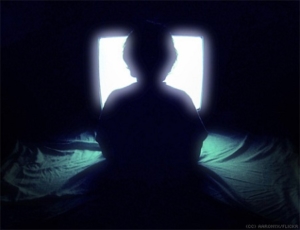 Most of us know the recommendations against TV viewing for children under 2 years of age and then the very limited screen time for children over 2. The recommendations are based on research that has found increased risk of various negative outcomes linked to TV or screen time or the quality of what is being watched. Many parents take this to heart and have a very strict no-screen rule for their kids whereas others seem to scoff at the recommendations and find them unnecessarily strict. In a day and age when screens are everywhere and they provide peace and quiet to stressed-out parents, it’s no wonder the recommendations can seem to be ignored.
Most of us know the recommendations against TV viewing for children under 2 years of age and then the very limited screen time for children over 2. The recommendations are based on research that has found increased risk of various negative outcomes linked to TV or screen time or the quality of what is being watched. Many parents take this to heart and have a very strict no-screen rule for their kids whereas others seem to scoff at the recommendations and find them unnecessarily strict. In a day and age when screens are everywhere and they provide peace and quiet to stressed-out parents, it’s no wonder the recommendations can seem to be ignored.
The question that some have had about the research is if TV viewing is the entire story and part of this stems from the fact that the results aren’t always so clear, depending on the outcomes being assessed. For example – and relevant to the new research – research on the effects of screen time on social adjustment has been mixed. This raises the question: is it the screen time or something else that is co-occurring resulting in the outcomes or simply one particular component of screen time? To this end, new research from Dr. Dylan Jackson from the University of Texas adds to the discussion
The Study
Data for the study comes from the Early Childhood Longitudinal Study, Birth Cohort (ECLS-B). The children in the study were born in 2001 and are representative of the national composition of the USA. Data for the ECLS-B is collected from ages 9 months to kindergarten and the data included herein was from the second collection point when the children were approximately 2 years of age (in or around 2003). One of the collection items at this point was the TV viewing habits of the child, including the involvement of the parent in viewing, what the child was viewing, and how much. As the children entered kindergarten, data on their learning, temperament, behaviour, and peer relationships were collected.
Specific outcomes included externalizing or disruptive behaviours (conduct problems) and social interactions with peers (social difficulties). The variables of interest pertaining to screen time were excessive viewing time (defined as 1 standard deviation above the mean), primarily adult programming viewing, and unattended viewing (index includes amount parents watch with the child, discuss the topics with the child, or engage in an activity afterwards that is related to what the child was viewing). Multiple covariates (15 in total) were included in the analyses to control for potentially confounding factors, including:
- Low socio-economic status
- Level of family conflict
- Female-headed household
- Low maternal involvement
- Maternal depression
- Maternal antisocial behaviour
- Maternal age
- The use of corporal punishment
- Low attachment security
- Child low cognitive ability
- Child low oral vocabulary
- Child negative temperament
- Child sex
- Child race
- Child age
A total of approximately 5,000 children had the full data necessary for these analyses.
Analyses were done using propensity matching which provides control cases to compare to the treatment cases in a quasi-experimental way that reduces bias. In English, this means that they were able to match children who met the criteria for the variables of interest (e.g., excessive TV viewing) and match them to a control (e.g., non-excessive TV viewing) based on how similar they were on the covariates. This reduces the effects of the covariates as the control and treatment cases are already matched (as close as can be) on these potential confounds. This mimics random assignment as best as we know how when random assignment isn’t possible.
The Findings
Approximately 10% of children were classified as watching predominantly adult programming, 16% of children met the criteria for excessive viewing, and approximately 16% also were classified as predominantly watching unattended. There were strong relationships between these variables and many of the covariates, suggesting that the covariates play a role in screen viewing habits, specifically low SES, family conflict, all maternal variables, child cognitive variables, and child race. Thus the propensity matching is necessary to try and determine if there are any effects above and beyond the effects of these covariates.
Once the propensity matching was done, the three groups based on screen time were compared on the two social outcomes. For excessive TV viewing, although there was a significant relationship to both conduct problems and social difficulties when the cases were not matched, when they were matched, that relationship became non-significant. This suggests that the previous findings that have linked total screen time to social outcomes may be reflective of these other covariates that are related to both the total screen time and the social outcomes.
For the comparison with adult programming, the results for both social difficulties and conduct problems were significant when the cases were not matched. When matched, the results for social difficulties remained significant, suggesting that predominantly watching adult content on screen has an independent effect on how children interact with other kids. This is not too surprising if you think about the types of behaviours that are prominent in adult viewing that may not be appropriate for child interactions. When looking at conduct problems, however, the results became non-significant when matching was employed, again suggesting previous results with aggression and other externalizing behaviours may be more influenced by these other factors.
Finally, when looking at unattended viewing and conduct problems, the results were non-significant for both unmatched and matched analyses; however, when looking at social difficulties, the results were significant in both cases, again suggesting an independent influence of watching unattended on children’s interactions with peers. This may reflect an overlap with the other two variables (unattended was also linked to both excessive viewing and adult programming compared to attended viewing) or may reflect the lack of social understanding that comes with attentive parents explaining some of what is being seen.
What It Means
This research highlights the previous limitations in other studies that failed to truly account for potential confounding variables when looking at screen time. Like many things, screen time does not occur in isolation and often takes place in contexts that are less supportive overall (as reflected by the findings herein) which have their own unique impact on children’s development. It is noteworthy that the findings with conduct problems were completely negated when matching took place, providing evidence that the fear of externalizing behaviours associated with screen time is unfounded and in fact we would be better looking to support families who are otherwise marginalized if we want to actually reduce conduct problems in childhood.
Equally notable was that the findings with social difficulties remained for two of the screen variables – adult programming and watching unattended – but not excessive viewing. This has implications for one of the more prominent theories on why there are negative associations with screen time which has been called the time displacement theory. This theory presupposes that the problems with screen time are not inherent in the screen time, but rather the time taken away from other activities that would promote social skills, cognitive skills, and overall social-emotional well-being. However, if total viewing time did not seem to affect these outcomes, this would suggest another factor may be at play. One possibility is that both child and adult programming require input from adults to help children contextualize what they are seeing and that this is even greater for adult programming which has themes and images that a young mind would struggle to comprehend even with adult input. Thus it may be that the added information and context that adults provide in books and other forms of media is equally if not more important for screens.
There are limitations worth discussing though. The first is that all content is not the same, which is particularly important for the type of content children are watching and whether or not it is unattended. By this, I mean that, for example, a sporting event would be considered “adult” but would not likely have the same effect as a child watching CSI or even the news. Similarly, children’s content can be more or less benign, especially in how it depicts social situations and engagement. Further, children’s content is still stratified by age and thus a 2-year-old watching shows aimed at 7- or 8-year-olds would likely struggle with context more than if he or she were watching Daniel Tiger’s Neighbourhood.
Second, the research does not account for how children watch television. Children can be active or passive viewers to what is on the screen and the effects of each may be quite different. Children who are actively watching are more likely to act out what they are seeing, possibly providing parents with a chance to intervene if needed and seeing undesirable behaviours or simply to see what the child is gleaning (which may not be negative at all, depending on what the child is watching). Children who are passively watching may not elicit the same type of engagement with others.
Third, the research took place in 2003 for the collection of television data. It would be wrong to assume that viewing habits are the same then as they are now. For example, children have more access to on-demand viewing through the use of popular platforms like Netflix and even online. Children also have more access to hand-held devices to watch which may be qualitatively different than watching on a larger screen in a room where other movement and behaviour of others is noted. This research would be best to be replicated in a more modern sample when possible.
Fourth, the research does not speak to television viewing habits earlier than the 2 years of age examined herein. It is probable that the children in this study were watching previous to 2. It’s rare for children to go from no screens to excessive viewing at 2 years, but not impossible. However, the effects of screen time may be more pronounced and biological in nature prior to 2 due to the rapid neurological development taking place. Research into this younger age group is necessary.
Finally, the research does not look at other outcomes for which there are stated effects. For example, there is research linking screen time to a greater risk for overweight or obesity in childhood (e.g.,[2][3]), sleep quality and quantity (e.g., [4][5]), quality of interactions with parents (e.g., [6]), and cognitive and motor skills (e.g., [7]). None of these were included in the current analysis and it may be that the effects here are independent of other factors that are often clustered in disadvantaged communities; however, more research of a higher quality is needed to unpack these associations.
Overall, the research is informative when it comes to the issue of antisocial behaviours and social interactions and television viewing in the toddler years, but does not address all of the questions and concerns surrounding television viewing. As the author states, he does not believe the research counters the recommendations to restrict viewing at young ages, but does caution that more research is needed to better understand the relationships and hopefully target the right areas. I believe that is a fair assessment and look forward to more research that helps to disentangle these various relationships.
_____________________
[1] Jackson DB. Does TV viewing during toddlerhood predict social difficulties and conduct problems? Infant and Child Development 2018; 27: e2086. https://doi.org/10.1002/icd.2086. [2] Dennison BA, Erb TA, Jenkins PL. Television viewing and television in bedroom associated with overweight risk among low-income preschool children. Pediatrics 2002; 109: 1028-1035. [3] Twarog JP, Politis MD, Woods EL, Boles MK, Daniel LM. Daily television viewing time and associated risk of obesity among U.S. preschool aged children: an analysis of NHANES 2009-2012. Obesity Research & Clinical Practice 2015; 9: 636-638. [4] Brockmann PE, Diaz B, Damiani F, Villarroel L, Nunez F, Bruni O. Impact of television on the quality of sleep in preschool children. Sleep Medicine 2016; 20: 140-144. [5] Hale L, Guan S. Screen time and sleep among school-aged children and adolescents: a systematic literature review. Sleep Medicine Reviews 2015; 21: 50-58. [6] Skaug S, Englund KT, Wichstrom L. Young children’s television viewing and the quality of their interactions with parents: a prospective community study. Scandinavian Journal of Psychology 2018; 59: 503-510. [7] Lin YL, Cherng RJ, Chen YJ, Chen YJ, Yang HM. Effects of television exposure on developmental skills among young children. Infant Behavior and Development 2015; 38: 20-26.





I agree, the relationship with screen time is very tangled, and frankly I wonder if screen time is not destructive in its own right, but may simply be a symptom of a deeper problem in society. The lack of a safe social structure for children to participate in, such as safe neighborhoods and other kids to play with outside (or parents who won’t allow children to play outside of the home, which is more frequent); the need to wind down after long and draining school hours (which for me as a child was one of the primary factors that triggered may own binge watching); and parents working long hours who are unable to really interact and engage with their kids after work. There are so many variables that haven’t been examined yet. It will be interesting to see how further research will bear out.